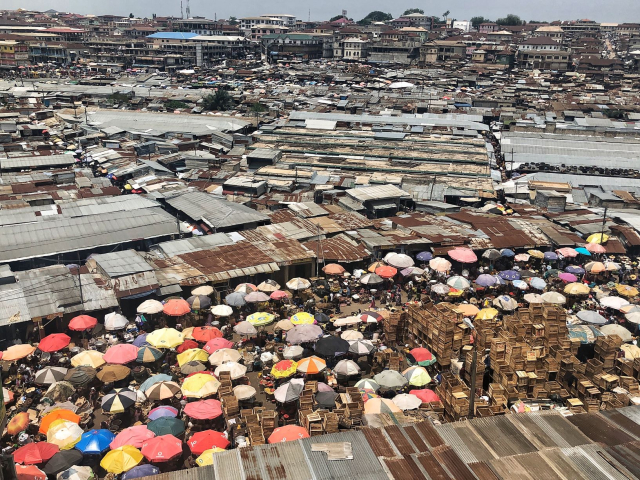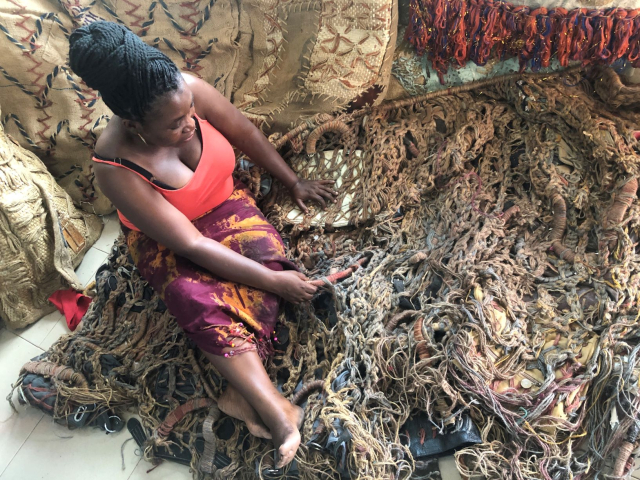Visiting Ibrahim Mahama, in Tamale
To better understand Ibrahim Mahama’s new monumental installation in Milan, we’ve been to Ghana, attending the opening of the art centre he founded in his hometown.

Ibrahim Mahama, A Friend, Fondazione Trussardi, 2019, Milan. Ph. Stefano Pirovano.

Kejetia market, Kumasi, Ghana, 2019. Ph. Jasmina Trifoni.
—
“Who is your reference in Ghana?”, asks me the consular officer, raising his eyebrows after reading on the visa application form my ‘profession’ (journalist) and the ‘purpose’ of my journey (tourism).
«Ibrahim Mahama» I reply.
The officer goggles at me. “Do you know Ibrahim Mahama? Why are you going to visit him?”
“Of course I do. He is the most famous African artist under 40, and I’m going to Ghana for the opening of his contemporary art centre, in Tamale, his birthplace”. I’d like to add that Ibrahim Mahama will be the superstar of the Ghana Pavillion at the next Venice Biennale where the country will officially partecipate this year for the first time. But the officer doesn’t give me the time to do so, and simply dismisses the whole matter: “Oh, I see. He just has the same name. Here ‘Ibrahim Mahama’ is a rather common name indeed”.
When I leave the Embassy – with the visa stamp in my passport – I google ‘Ibrahim Mahama’, thus finding out that Ibrahim Mahama, the other Ibrahim Mahama, is actually the brother of the former President of Ghana, a businessman and by the way the owner of many mining companies in his country, in Liberia, in the Republic of the Congo and in Sierra Leone. He is the richest man in Ghana. And, needless to say, the most talked-about one.

Savannah Centre for Contemporary Art, Tamale.
The Savannah Centre for Contemporary Art.
Be that as it may, a few days later I am in Tamale, with Francesca Migliorati, director of A Palazzo Gallery in Brescia, the first European gallery including Ibrahim Mahama in its roster. Located in the northern region of Ghana, not far from the border with Burkina Faso, Tamale is a torrid and dusty (to put it mildly) sprawling of small houses in the Sub-Saharan Savannah, quite different from the notion of city we have in Europe. It is the eve of the opening of the Savannah Centre for Contemporary Art (SCCA). With the help of a small group of collaborators Ibrahim Mahama is putting the finishing touches to the set up of the opening exhibition, a retrospective dedicated to the almost 80-year-old Ghanaian artist Galle Winston Kofi Dawson who, little known abroad, coined in the Seventies the term Afro-Journalism to describe his politically and socially-committed art practice. The curator, Bernard Akoi-Jackson, titled the exhibition ‘In Pursuit of Something Beautiful, Perhaps…’. This title seems perfect also to describe the extraordinary building that hosts the show and that, funded and carefully projected by the same Ibrahim Mahama (the artist, of course), is a proper Kunsthalle, with an annexed library dedicated to art and architecture, which will make many European cities green with envy.

Galle Winston Kofi Dawson (left) with Ibrahim Mahama, 2019, ph. Jasmina Trifoni.
“The international art world has given a lot to me”, explains Mahama. “And now that I am 32 years old (!), I feel I need to give something back to the community where I grew up and that made me an artist”. After the retrospective on Galle Winston Kofi Dawson, SCCA will keep on exhibiting Ghanaian artists from an earlier generation. Meanwhile I’m working on a project to widen my studio by building new spaces in order to give the opportunities to artists of my own country to work and exhibit there. I’m developing artist residency programs too.”

Galle Winston Kofi Dawson, Coal-Pot Fire, 2003. Oil on canvas. 89 x 67 cm. Courtesy of the artist and Savannah Centre for Contemporary Art, Tamale and the artist.

Galle Winston Kofi Dawson, Corn, 1986. Oil on canvas. 121 x 76 cm. Courtesy of the artist and Savannah Centre for Contemporary Art Tamale.
Ibrahim Mahama’s studio and pluralism.
Just a few kilometres away from SCCA, there is his studio – once again, to say the least. It is indeed an immense site, with two brick buildings, as big as hangars, where more than 100 people are engaged to produce his monumental installations, while workers are busy at work to make his extraordinary African utopia a reality. In Mahama’s plans, who decided to stay in Ghana and to live here, this site in the Savannah will host a school, workshops, a garden with native plants and an organic cultivation of Shea trees, a typical tree from this northern area of the country; from its seed it is produced the precious butter worldwide used for cosmetics purposes. Interesting fact, you’ll find here also a plane carcass that the artist bought (and had it delivered by truck from the capital Accra) some time ago and that he will probably use later on for one of his installations.

Exhibition opening at Savannah Centre for Contemporary Art, Tamale.
As opposed to the individualism typical of many artists, Ibrahim Mahama considers his art a ‘collective work’: it is not by chance that his recent installation at the Norval Foundation in Cape Town is actually titled Labour of Many. And it is indeed a matter of Many, so to speak, also the great opening of SCCA, the next day, proving how much ‘our’ Mahama – with all due respect to the embassy officer and to Ibrahim Mahama, the tycoon, in this case – is loved and appreciated by a surprisingly large and mixed local contemporary art crowd. There is a parade of coaches coming for the occasion from Accra (10 hours drive) and from Kumasi (‘just’ 4 hours), the city where the artist studied, at the College of Arts and Built Environment of the Kwame Nkrumah University of Science and Technology (KNUST). They are students and friends who come for a celebration that has nothing to do with the elitist, often disturbing, similar high-profile events that take place in Italy. Or, generally speaking, in the so-called developed countries. Just to give an example, at the talk between the artist and the curator, presented by a Mahama who prefers to be into the background, there are at least two hundred people, including many elementary school students, who are not afraid to stand up and ask very precise and smart questions. Amongst the guest stars, there is Professor Karikacha Seidou, dean of the Faculty of Art, tutor of Mahama and a ‘living deity’ for all the university students. “He is a great man and artist, but he never wanted to leave Ghana”, explains Ibrahim Mahama. While Samuel Baah, his student as well as a talented emerging artist, adds: “One day I asked him If he could take me to his studio to see his works, and he replied – ‘The best artworks are you, the students”.

Dorothy Amenuke, 2019, ph. Jasmina Trifoni.
At the Kejetia market.
After Tamale, my journey to discover the world of Ibrahim Mahama continues in the bustling city of Kumasi which, also thanks to College of Arts and Built Environment that is considered the most prestigious one on the continent (as well as being the first one in Africa to launch a curatorial studies course) and attended also by European and American students, is the heart of Ghana’s artistic creation. In a country where there isn’t any public institution dedicated to contemporary art and where the majority of people understand ‘art’ only in terms of portraits by commission and religious paintings (this is a piously and pluralistically Christian country) made by a plethora of roadside artists – the young people landing at KNUST go through an experience that will change their life forever. “During my classes I teach them that colours are not only ones of crayons or in tubes. I tell them: walk around Kumasi, and find the colour, and art, in everyday life and everyday things. This has always a striking effect on them.” This is what Dorothy Amenuke, artist (some of her works are actually part of the collection of the Stedelijk Museum in Amsterdam) and professor of drawing and sculpture at the university recounts. “Initially also Ibrahim thought I was crazy. Then, however, he managed to perfectly grasp this concept”. If it is evident by looking at the delicate and feminine soft sculptures by Dorothy Amenuke in her studio that Mahama owns a lot to her on a conceptual and aesthetic level, I only fully understood his art when I went to Kejetia, Kumasi central market, the largest open-air market in West Africa. Jute sacks – and the ‘colour’-, raw materials in his research, seem to be a constant part of an extremely powerful geographical and human scenery. Fabricated in India and Bangladesh and here imported by the Ghana Cocoa Board to transport cocoa beans which is the chief agricultural export of the country – the second largest cocoa exporter in the world –, the sacks are patched and consecutively reused to transport charcoal and other commodities from rural areas to the cities. Through these sacks that are stitched together – and that in his installations become the second skin, injured, of monumental buildings – Mahama tells a story which explores themes like commodity, labour, effort and social inequalities. This story ideally starts from this market, but is of global importance. This is why these days that his exceptional installation titled ‘A friend’ where the juta sacks, and the Labour of Many, can be seen wrapping the Porta Venezia toll gates, thanks to the Fondazione Trussardi, let’s not make the mistake to dismiss this great artist simply as “the Christo from Africa”. It may instead be useful to take time to ponder over how much the work and the resources of an invisible Africa, or known only through stereotypes, are actually part of our everyday life, despite what a ‘Salviniana’ Italy wants us to believe. This is what art, which is truly contemporary, is needed for.
November 25, 2020
